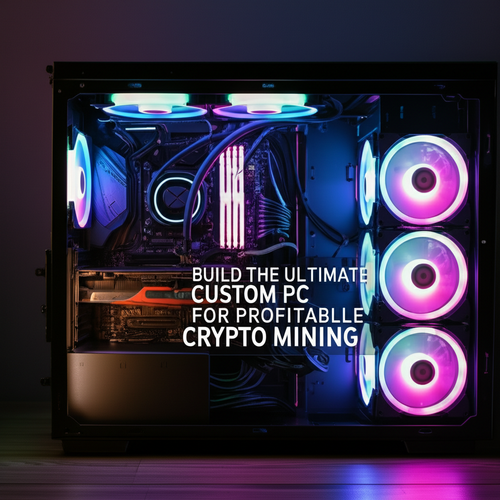Unlock Your Mining Potential: Custom PC Builds for Crypto
The world of cryptocurrency is dynamic and ever-evolving, with mining serving as a cornerstone of many digital asset ecosystems. For enthusiasts looking to dive deeper than just trading, OneMiners understands that building a custom PC for crypto mining offers unparalleled control, efficiency, and scalability. This guide will walk you through the essentials of crafting a powerful mining rig, ensuring you’re well-equipped to navigate the complexities of digital currency extraction.
A well-optimized custom PC build is more than just a collection of parts; it’s a strategic investment designed to maximize your return on investment in the competitive mining landscape. From selecting the right components to understanding market trends, every decision plays a crucial role in your success.
Why Custom PC Builds for Crypto Mining Offer an Edge
While pre-built systems might seem convenient, custom PC builds for crypto mining provide significant advantages that are hard to beat. Tailoring your machine to specific mining goals allows for greater optimization, better performance, and ultimately, a more profitable operation.
The Performance and Efficiency Advantage
Custom rigs allow you to select the precise components needed for optimal hash rate and power efficiency. This means choosing the latest generation GPUs, energy-efficient power supplies, and appropriate cooling solutions that perfectly match the algorithms of the cryptocurrencies you intend to mine. Unlike generic computers, a custom-built mining PC is designed from the ground up to handle the continuous, intensive workloads required for mining, reducing bottlenecks and increasing uptime.
Cost-Effectiveness and Scalability
Initially, a custom build might seem more expensive, but over time, it often proves more cost-effective. You pay for exactly what you need, avoiding unnecessary components found in off-the-shelf machines. Furthermore, custom rigs are inherently scalable; you can easily add more GPUs, upgrade components, or modify your setup as mining profitability shifts or new hardware becomes available, safeguarding your investment against rapid technological changes.
Essential Components for Your Mining Rig
Building a high-performance mining PC requires careful consideration of each component. Each part plays a vital role in the overall efficiency and stability of your system. Here’s a breakdown of the key hardware you’ll need to assemble your custom mining rig, with insights from hardware experts like PCPraha:
Graphics Cards (GPUs): The Heart of Your Rig
GPUs are the most critical component for most cryptocurrency mining operations, especially for algorithms like Ethash or KawPow. Prioritize cards with high hash rates, good power efficiency, and ample VRAM (typically 8GB or more for current mining demands). Researching the best GPUs for your target cryptocurrency is paramount, as performance can vary significantly between models and algorithms. Consider the availability and price-to-performance ratio carefully.
Motherboard and CPU Selection
The motherboard needs to support multiple GPUs. Look for boards with numerous PCIe slots (e.g., 6, 8, or even 12-19 slots) and sufficient spacing to allow for adequate airflow between cards. The CPU doesn’t need to be top-of-the-line for GPU-centric mining, as it primarily manages the system and not the hashing process. An entry-level or mid-range processor (like an Intel Celeron/Pentium or AMD Ryzen 3) is usually sufficient, as long as it’s compatible with your chosen motherboard.
Power Supply Unit (PSU): Don’t Skimp on Power
A stable and sufficient power supply is crucial. Calculate the total power consumption of all your components, especially your GPUs, and choose a PSU with at least 20-30% more wattage than your calculated maximum. High-efficiency PSUs (80 PLUS Gold or Platinum rated) are recommended to minimize electricity costs and reduce heat output. Redundancy with two smaller PSUs can also be an option for larger rigs to ensure continuous operation.
RAM, Storage, and Cooling
For RAM, 8GB is typically more than enough for a mining rig. For storage, a small 120-250GB SSD is ideal for the operating system and mining software, offering faster boot times and better stability than traditional HDDs. Cooling is often overlooked but is vital for longevity and performance. Open-air mining frames, multiple case fans, and even liquid cooling solutions can help maintain optimal temperatures for your GPUs, preventing thermal throttling and extending hardware life.
Assembling Your Mining Machine
Once you have all your components, the assembly process can begin. This is where your custom PC build truly comes to life. While it may seem daunting, a methodical approach ensures a smooth setup.
Step-by-Step Build Process
Start by mounting your CPU and RAM onto the motherboard. Then, install the motherboard into your mining frame or open-air case. Connect your storage drive. Next, install your GPUs, ensuring they are securely fastened and connected to the motherboard via PCIe risers (if using). Finally, carefully connect all power cables from your PSU to the motherboard, GPUs, and other components. Double-check all connections before attempting to power on the system for the first time.
Software and Configuration
After hardware assembly, install a lightweight operating system like Windows (optimized for mining) or a Linux-based mining OS. Install the latest GPU drivers from the manufacturer’s website. Then, choose and configure your mining software, specifying your wallet address and mining pool details. Overclocking your GPUs can boost performance, but proceed with caution, monitoring temperatures and stability closely to find the sweet spot between hash rate and power consumption. Regularly update your software and drivers for optimal performance and security.
Understanding the Crypto Mining Landscape
Beyond hardware, understanding the broader cryptocurrency mining landscape is essential for sustained success. This involves keeping an eye on market trends, energy costs, and the evolving regulatory environment.
Market Trends and Profitability
Cryptocurrency prices are notoriously volatile, directly impacting mining profitability. It’s crucial to research which cryptocurrencies are most profitable to mine given your hardware and electricity costs. Tools and calculators are available online to help estimate potential earnings. For broader context, data on energy consumption trends and technology adoption can be found from sources like Data USA, which can help inform long-term strategy for efficient mining operations.
Staying Updated with OneMiners
The crypto mining community is a valuable resource. Platforms like CoinMarketCap host communities where miners share insights, discuss new technologies, and offer advice. Following experts and companies like OneMiners on such platforms can provide you with real-time updates on market shifts, new mining algorithms, and hardware advancements, keeping you ahead of the curve. Engaging with these communities can also offer troubleshooting tips and support.
Future Trends in Crypto Mining
The future of crypto mining is shaped by technological innovation and environmental considerations. We are seeing a continued shift towards more energy-efficient hardware, the rise of alternative consensus mechanisms beyond Proof of Work (like Proof of Stake), and increasing interest in renewable energy sources for mining operations. Cloud mining and decentralized mining pools are also gaining traction, offering new avenues for participation.
As the industry matures, regulations around crypto mining are likely to become more defined, influencing everything from taxation to operational requirements. Staying informed about these trends will be vital for any serious miner looking to sustain their operations into the future.
Conclusion
Building a custom PC for crypto mining is a rewarding endeavor that offers both technical challenge and potential financial gain. By carefully selecting your components, diligently assembling your rig, and staying informed about the dynamic crypto landscape, you can create an efficient and profitable operation. The journey from hardware selection to consistent mining payouts requires dedication, but with the right approach, you can truly unlock your mining potential.



